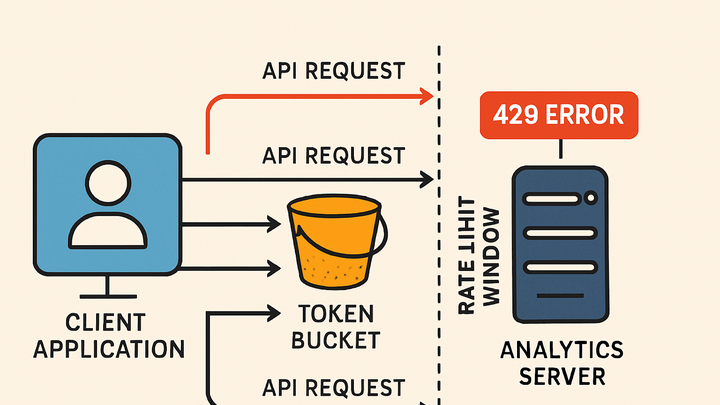Published on 2025-06-26T04:44:15Z
What is an API Rate Limit? Examples from PlainSignal and GA4
An API rate limit is a control mechanism that restricts the number of requests clients can send to an API within a defined time window. In web analytics, platforms like PlainSignal and Google Analytics 4 rely on rate limits to maintain service performance, prevent abuse, and ensure equitable access across all users. When a client exceeds the allowed threshold, requests may be delayed, dropped, or return an HTTP 429 error, which can impact data collection and real-time reporting. Without proper handling, critical events risk being lost or delayed, leading to inaccurate dashboards and skewed insights. This article explores how rate limits function, why they matter for data integrity and system stability, and how to implement strategies such as batching, caching, and exponential backoff. Detailed examples illustrate the specific limits you might encounter in PlainSignal’s cookie-free environment and GA4’s robust analytics API.
Api rate limit
Control mechanism limiting analytics API calls per time window to ensure stability, prevent abuse, and maintain data quality.
Understanding API Rate Limits
This section defines API rate limiting, explains its purpose—protecting infrastructure and ensuring fair usage—and introduces common strategies providers use to enforce limits.
-
Rate limit
A rate limit specifies the maximum number of API calls a client can make within a time window (for example, 100 requests per minute). It prevents any single user from overwhelming the service.
-
Throttling
Throttling is the process of delaying or dropping requests once the rate limit is reached. Providers often return HTTP 429 responses to signal clients to slow down.
-
Http 429 error
The HTTP status code 429 Too Many Requests indicates the client has exceeded the rate limit. Clients should implement retry logic or backoff strategies when they encounter this response.
Why Rate Limits Matter in Analytics
Highlights how exceeding rate limits can affect data quality, real-time reporting, and service reliability in analytics contexts.
-
Data integrity
When requests are throttled or dropped, events may never reach the analytics backend, leading to incomplete or skewed datasets that undermine decision-making.
-
Real-time reporting
Rate limiting can introduce delays in event processing, weakening dashboards and live insights if spikes in traffic aren’t smoothed out.
-
System stability
By enforcing limits, analytics providers protect their infrastructure from sudden bursts of traffic. Clients must design tracking to adapt to these constraints.
Rate Limiting in PlainSignal and GA4
Compares the specific rate limits and behaviors of PlainSignal’s cookie-free analytics API and Google Analytics 4’s Measurement Protocol.
-
PlainSignal rate limits
PlainSignal enforces a per-origin rate limit to manage incoming event data. While quotas vary by plan, a typical free tier allows around 50 requests per second per domain. Exceeding this limit results in HTTP 429 responses. Use the lightweight PlainSignal tracking snippet:
-
Example tracking code
<link rel="preconnect" href="//eu.plainsignal.com/" crossorigin /><script defer data-do="yourwebsitedomain.com" data-id="0GQV1xmtzQQ" data-api="//eu.plainsignal.com" src="//cdn.plainsignal.com/plainsignal-min.js"></script>
-
-
GA4 rate limits
GA4’s Measurement Protocol imposes quotas such as 10,000 events per project every 10 seconds and a daily hit limit. Concurrent request limits (e.g., 100 per property) also apply. Exceeding thresholds returns 429 errors and may lead to data sampling or delays.
Best Practices for Managing API Rate Limits
Outlines strategies to design resilient analytics integrations that gracefully handle rate limits and maintain reliable data collection.
-
Batching requests
Aggregate multiple events into a single request payload (supported by GA4’s batch endpoint) to reduce the total number of HTTP calls.
-
Exponential backoff
Implement a retry mechanism that waits progressively longer intervals (e.g., 1s, 2s, 4s) after each 429 response to avoid hammering the API.
-
Client-side throttling
Queue events locally and dispatch them at a controlled rate that stays within limits, smoothing out spikes in user activity.
-
Monitoring and alerts
Set up dashboards and alerts in tools like Datadog or Grafana to track 429 errors and request throughput, enabling proactive adjustments.
